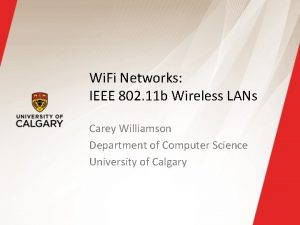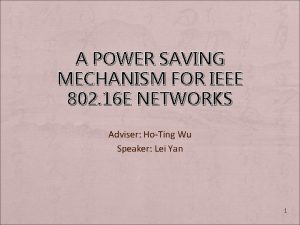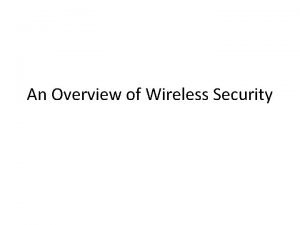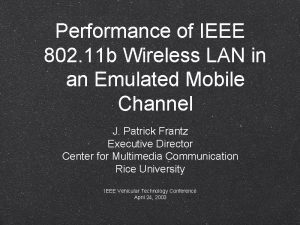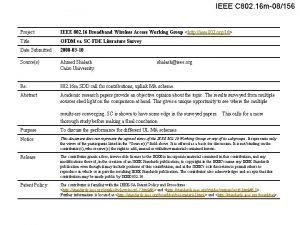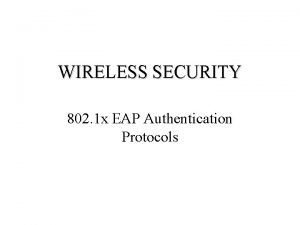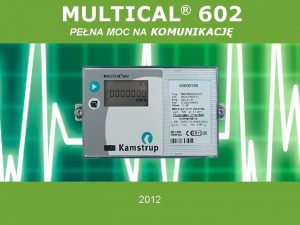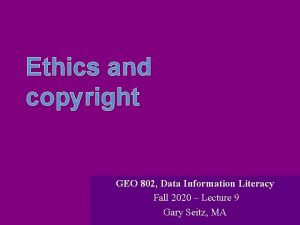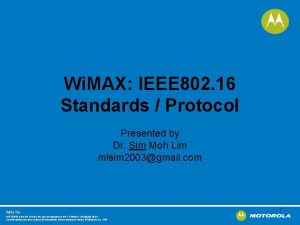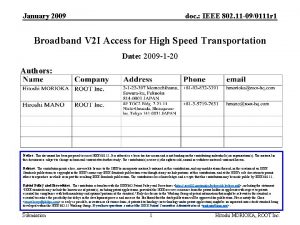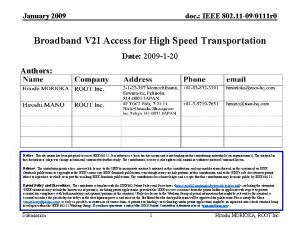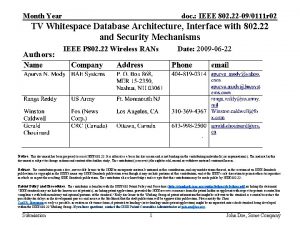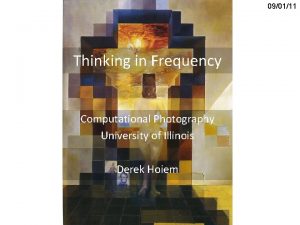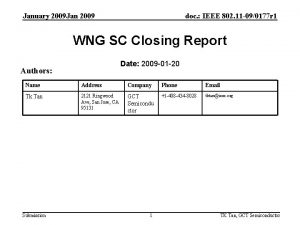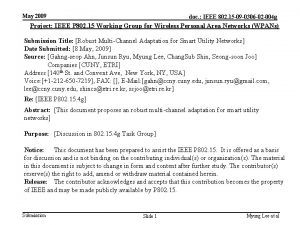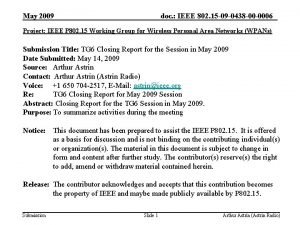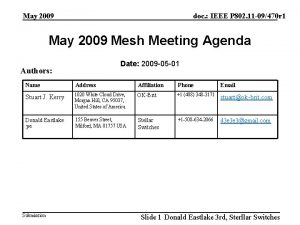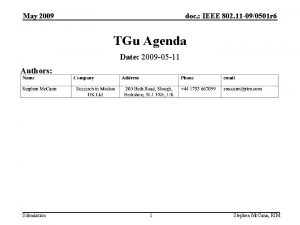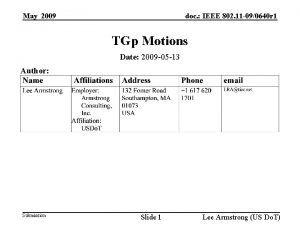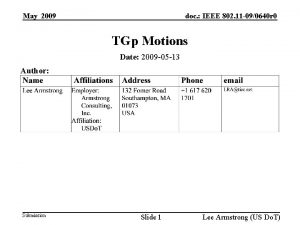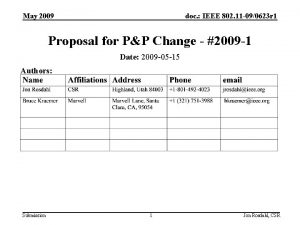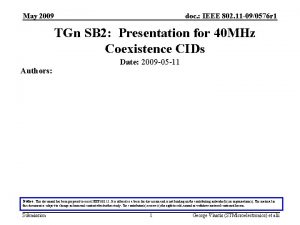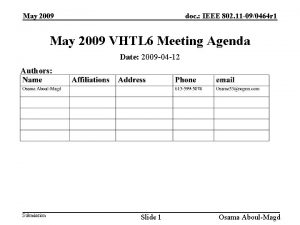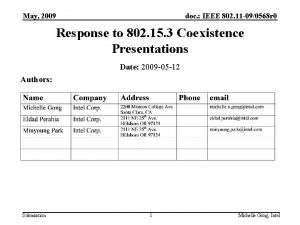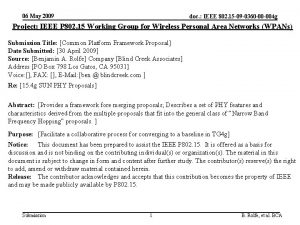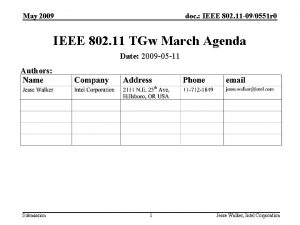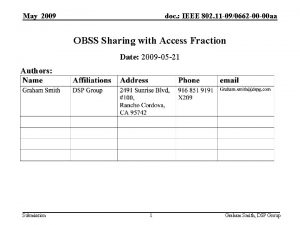May 2009 doc IEEE 802 11 090111 r






















- Slides: 22

May 2009 doc. : IEEE 802. 11 -09/0111 r 2 Broadband V 2 I Access for High Speed Transportation Date: 2009 -5 -12 Authors: Notice: This document has been prepared to assist IEEE 802. 11. It is offered as a basis for discussion and is not binding on the contributing individual(s) or organization(s). The material in this document is subject to change in form and content after further study. The contributor(s) reserve(s) the right to add, amend or withdraw material contained herein. Release: The contributor grants a free, irrevocable license to the IEEE to incorporate material contained in this contribution, and any modifications thereof, in the creation of an IEEE Standards publication; to copyright in the IEEE’s name any IEEE Standards publication even though it may include portions of this contribution; and at the IEEE’s sole discretion to permit others to reproduce in whole or in part the resulting IEEE Standards publication. The contributor also acknowledges and accepts that this contribution may be made public by IEEE 802. 11. Patent Policy and Procedures: The contributor is familiar with the IEEE 802 Patent Policy and Procedures <http: // ieee 802. org/guides/bylaws/sb-bylaws. pdf>, including the statement "IEEE standards may include the known use of patent(s), including patent applications, provided the IEEE receives assurance from the patent holder or applicant with respect to patents essential for compliance with both mandatory and optional portions of the standard. " Early disclosure to the Working Group of patent information that might be relevant to the standard is essential to reduce the possibility for delays in the development process and increase the likelihood that the draft publication will be approved for publication. Please notify the Chair <stuart. kerry@philips. com> as early as possible, in written or electronic form, if patented technology (or technology under patent application) might be incorporated into a draft standard being developed within the IEEE 802. 11 Working Group. If you have questions, contact the IEEE Patent Committee Administrator at <patcom@ieee. org>. Submission 1 Hitoshi MORIOKA, ROOT Inc.

May 2009 doc. : IEEE 802. 11 -09/0111 r 2 Abstract • We talk about WLAN broadband access for high speed transportation. – – – Motivation Market Applications Why Wi-Fi? Why standardization is needed? Requirement • Handover Latency Case Study – Comparison with Existing IEEE 802. 11 Standards – Straw Poll Submission 2 Hitoshi MORIOKA, ROOT Inc.

May 2009 doc. : IEEE 802. 11 -09/0111 r 2 Motivation • Many high speed trains (>200 km/h) are already in operation in Europe and Asia. • Developments of 10, 000 km of express railway tracks are estimated in next 20 years in the world. • Train operators want broadband network between rail-side and train for such as train survey, passenger service and so on. • And they want to operate the network by their own. Wi-Fi will meet their needs. (Equipments cost, Operation cost, Bandwidth…) Submission 3 Hitoshi MORIOKA, ROOT Inc.

May 2009 doc. : IEEE 802. 11 -09/0111 r 2 Markets • • – – – • Shanghai Transrapid Beijing-Tianjin HSCL 236, 000 km 128, 000 km 110, 000 km 22 systems in operation in 15 countries. Expected new high speed train – – • North America: 278, 000 km EU: Russia: East Asia: Central/South America: Name Existing high speed train (> 200 km/h operation) – • Existing High Speed Train (> 300 km/h) Train (Railway Transportation) Total extension of railway is approximately 1, 350, 000 km in the world. 10, 000 km in next 20 years. In US, President Obama unveiled his plan to develop new high speed passenger railway. 430 km/h China 350 km/h TGV France 320 km/h ICE Germany 320 km/h Shinkansen Japan 300 km/h AVE Spain 300 km/h Eurostar EU 300 km Thalys EU 300 km/h Italy 300 km/h Taiwan 300 km/h Korea 300 km/h KTX Submission 4 Max. Speed China Treni Eurostar Italia Taiwan HSR Of cause, not only high speed train but also ordinary train can use this technology. Country Hitoshi MORIOKA, ROOT Inc.

May 2009 doc. : IEEE 802. 11 -09/0111 r 2 Expected Applications • • Internet Hot-spot service for passengers. Passenger information services. Cabin monitoring. Backbone for femtocell. – – Submission Subway Tunnel 5 Hitoshi MORIOKA, ROOT Inc.

May 2009 doc. : IEEE 802. 11 -09/0111 r 2 Backbone for Hot-spot Service • Passengers can access to the Internet while traveling at low price and high speed. Web Servers Mail Servers Roadside AP WLAN AP Train STA Internet Misc. Servers LAN Web Servers Submission 6 Hitoshi MORIOKA, ROOT Inc.

May 2009 doc. : IEEE 802. 11 -09/0111 r 2 Backbone for Femtocell • Passengers can use their celluler phone even in a tunnel or underground. Cellular Phone Network Roadside AP Femtocell Train STA Internet LAN Cellular Phone Network Submission 7 Hitoshi MORIOKA, ROOT Inc.

May 2009 doc. : IEEE 802. 11 -09/0111 r 2 Passenger Information Services • Passengers can get information such as news, travel information, advertisement in real time. Info. Servers Roadside AP Train STA Internet News Advertisement Travel Info… LAN Info. Servers Submission 8 Hitoshi MORIOKA, ROOT Inc.

May 2009 doc. : IEEE 802. 11 -09/0111 r 2 Cabin Monitoring • Train operators can monitor the cabin. Roadside AP Train STA Internet LAN Submission 9 Hitoshi MORIOKA, ROOT Inc.

May 2009 doc. : IEEE 802. 11 -09/0111 r 2 Why Wi-Fi? • Wi-Fi can be easily operated by train/railway operators. • It means the networks are under their control, not rely on others. • And Wi-Fi has world-wide interoperability on frequency use. Standards Equipment Cost Operation Cost 3 G, 3. 5 G 14. 4 Mbps (Downlink) 11. 5 Mbps (Uplink) Very High LTE 100 Mbps (Downlink) 50 Mbps (Uplink) Very High Wi. MAX (IEEE 802. 16 e) 21 Mbps High Low IEEE 802. 11 100 Mbps (11 n MAC) Low Submission Bandwidth 10 Hitoshi MORIOKA, ROOT Inc.

May 2009 doc. : IEEE 802. 11 -09/0111 r 2 Why standardization is needed? • Multiple vendor and long term support is needed for sustainable operation. • A train may run across multiple railway network. So inter-/intra-national interoperability is needed. • According to these reasons, international standardization is needed. Submission 11 Hitoshi MORIOKA, ROOT Inc.

May 2009 doc. : IEEE 802. 11 -09/0111 r 2 Requirements • Target Speed – – TGV plans 360 km/h operation. Trans. Rapid in Shanghai is operated in 430 km/h. JR-Maglev records 581 km/h and JR plans to start service in 2025. 500 km/h is enough? • Scalability – Many trains are running on a railway simultaneously. – Railway networks are vast. So a train may run across many communication networks. – Inter-network handover is required. • Security – Security is very important because private information will flow on networks. – For example, a train survey application will transfer a video which includes a passenger’s face. Submission 12 Hitoshi MORIOKA, ROOT Inc.

May 2009 doc. : IEEE 802. 11 -09/0111 r 2 Inter-Network Use Network A Network B AP AP Network C AP AP AP Inter-Network Handover Network D AP AP Inter-Network Handover IEEE 802. 11 r does not support inter-network handover. Submission 13 Hitoshi MORIOKA, ROOT Inc.

May 2009 doc. : IEEE 802. 11 -09/0111 r 2 Inter-network Handover Latency 1. Discover a new AP. • Latency can be reduced by 11 k or multiple radio interfaces. 2. Association with new AP. (includes authentication/key exchange…) • • 11 i authentication is NOT fast. It needs many packet exchanges. 3. Network layer setup. Submission 14 Hitoshi MORIOKA, ROOT Inc.

May 2009 doc. : IEEE 802. 11 -09/0111 r 2 MAC Requirements • Fast Association – Train must handover during passing overlap zone for seamless handover. – Handover latency impacts distance between APs. (= cost) – Low handover latency is needed. Old AP New AP Overlap Zone Submission 15 Hitoshi MORIOKA, ROOT Inc.

May 2009 doc. : IEEE 802. 11 -09/0111 r 2 Case Study • Assumption – Maximum speed: 500 km/h = 140 m/s – Cell Radius: 200 m – Route Length: 1, 000 km Case 1: Handover Latency = 100 ms Minimum Overlap Zone length= 14 m Distance between adjacent APs = 386 m Number of APs = 2, 591 Old AP New AP 200 m 14 m 200 m 386 m Submission 16 Hitoshi MORIOKA, ROOT Inc.

May 2009 doc. : IEEE 802. 11 -09/0111 r 2 Case Study (cont. ) Case 2: Handover Latency >1. 43 s Minimum Overlap Zone distance > 200 m Old AP New AP 200 m STA must begin new handover process before completing old handover process. Submission 17 Hitoshi MORIOKA, ROOT Inc.

May 2009 doc. : IEEE 802. 11 -09/0111 r 2 Protocol Sequence of IEEE 802. 11+IEEE 802. 1 x(EAP-MD 5) • At least 6 roundtrip packet exchanges STA between STA and AP, and 2 roundtrip packet exchanges between AP and RADIUS server are needed. • EAP-TLS, EAP-TTLS, etc. needs more packet exchanges. It increases handover latency AP Beacon Probe Request Probe Response Authentication Request Authentication Reply Association Request Association Accept EAPOL-Start EAP-Request/Identity EAP-Response/Identity EAP-Request/Credentials EAP-Response/Credentials EAP-Success Submission 18 RADIUS Server RADIUS-Access-Request RADIUS-Access-Challenge RADIUS-Access-Request RADIUS-Access-Accept Hitoshi MORIOKA, ROOT Inc.

May 2009 doc. : IEEE 802. 11 -09/0111 r 2 Comparison with Existing IEEE 802. 11 Standards Inter-Network Security Use Fast Roaming (Handover) IEEE 802. 11/a/b/g/n +IEEE 802. 11 i +IEEE 802. 11 r We need Approaches a. b. Submission Fast authentication/key exchange. Inter-network fast roaming. 19 Hitoshi MORIOKA, ROOT Inc.

May 2009 doc. : IEEE 802. 11 -09/0111 r 2 PHY Compatibility • Existing PHY can be used in high speed environment. (08/1020 r 1) • So existing WLAN chipset can be used with some firmware and/or driver modification. LOW COST Submission 20 Hitoshi MORIOKA, ROOT Inc.

May 2009 doc. : IEEE 802. 11 -09/0111 r 2 Questions & Comments Submission 21 Hitoshi MORIOKA, ROOT Inc.

May 2009 doc. : IEEE 802. 11 -09/0111 r 2 Straw Poll • “A Study Group to develop a PAR and 5 C for Highspeed Broadband Access for 802. 11 should be created” Yes: No: Don’t Know, Need More Discussion: Don’t Care: Submission 22 Hitoshi MORIOKA, ROOT Inc.
 Bridges from 802.x to 802.y
Bridges from 802.x to 802.y Bridges from 802.x to 802.y
Bridges from 802.x to 802.y Ieee 802 3 compliance
Ieee 802 3 compliance Ieee802.22
Ieee802.22 Arquitetura ieee 802
Arquitetura ieee 802 Modelo ieee 802
Modelo ieee 802 Ieee 802 standard
Ieee 802 standard Ieee 802 bluetooth
Ieee 802 bluetooth 802 ieee
802 ieee Ieee 802
Ieee 802 Ieee 802 family
Ieee 802 family Hci patterns may or may not include code for implementation
Hci patterns may or may not include code for implementation 802 11 b
802 11 b 802 16
802 16 802-11-wireless-security
802-11-wireless-security Bus topology
Bus topology 802 11 b
802 11 b Mac address
Mac address 802 16
802 16 802 eap
802 eap Multical 602
Multical 602 Geo 802
Geo 802 802 16
802 16












